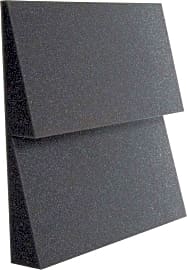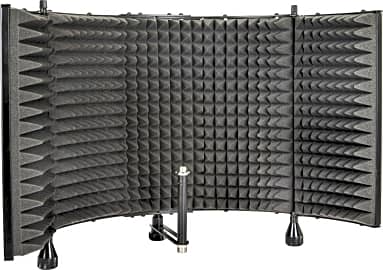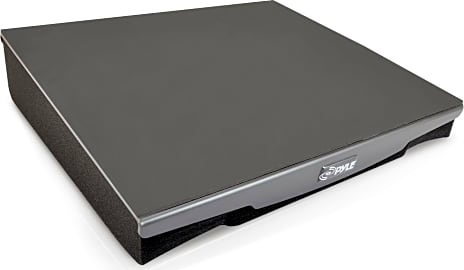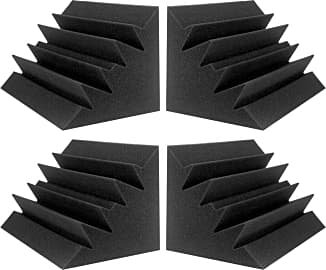The 10 Best Acoustic Foams

This wiki has been updated 36 times since it was first published in February of 2016. Whether you are recording the next number one hit, producing voice-overs, or creating podcasts, without the proper acoustic treatment, the final product may be harsh or hollow, or contain artifacts like echo and slap-back. The right type of foam panels will curtail those problems, resulting in richer and cleaner audio reproduction. Some can also make a studio look professional, too. When users buy our independently chosen editorial recommendations, we may earn commissions to help fund the Wiki.
Editor's Notes
December 09, 2020:
For our latest update, we swapped in the Jber Bass Trap for its affordable price. It's designed to fit in corners to help minimize bass echo. We also included the Foamily Pyramid Panels, which are great for small to medium-sized rooms in need of moderate sound-treatment. They too are a solid choice for those on a budget. The rest of the Auralex choices were left on the list as no new products have emerged that are worthy of unseating these top-of-the-line products. They remain a great choice for anyone with a nice budget and an attention to detail.
December 11, 2019:
You may be aware of this, but it's worth mentioning that acoustic foam isn't really capable of isolating noise made in a studio; it's used specifically for dampening vibration and reverberation of mid-range and high-end sound. As far as price goes, it's tough to beat BookishBunny Egg Crate and Foamily Panels. The BookishBunny is especially easy to use thanks to its adhesive backing, though you may end up with a little waste if you do have to cut the relatively large sheet down to size. Alternately, the Foamily option is sized like traditional acoustic foam. Auralex Studiofoam is a step up in price as well as quality, made with slightly denser material than the less expensive ones.
If you're willing to make a considerable investment and want something that's definitively nice, rather than affordable and passable, Auralex Sonoflat and Studiofoam Metro might catch your eye. The jury is still out as to whether the Metro's rectangular design actually yields superior audio results, but it definitely looks better than standard egg crate or triangular foam paneling. The Sonoflat is pretty simple and costly, but performs on the level of high-end acoustic paneling. The same can be said of Jocavi Basmel Twist, which is especially costly but looks and sounds great when installed correctly.
We've also included some specialty pieces that dedicated sound engineers might really appreciate. The Auralex Lenrd is a bass trap that sits in the corner and helps to minimize low-end booming and the Monoprice Shield is a quality isolation shield that can help groups sound great even when making plenty of different noises in the same room. The Sound Addicted Pads and Pyle Isolation collection sit underneath medium-size monitors and keep the room's vibrations from unduly affecting their output.
A Far Cry From The Egg Crate
Firstly, we didn't know enough about audio engineering to really be able hear the difference between what these crates offered and what professional acoustic foam could do.
When I was in high school, my bandmates and I set out to transform our drummer's basement in to a recording studio. Without a lot of money to spend, we started tuning the room with egg crates, taking them from our respective parents' refrigerators as soon as they wore down to their last few eggs. Eventually, I started asking the local supermarket for crates they intended to discard, and we got enough material to cover most of the walls and ceiling.
The reason egg crates worked for us was twofold. Firstly, we didn't know enough about audio engineering to really be able hear the difference between what these crates offered and what professional acoustic foam could do. Secondly, the space sounded so bad to begin with that anything would have been a vast improvement.
As far as the physics go, the crates performed one of the two tasks acoustic foams are designed to perform. The bubbles where the eggs had been, when pointed outward off the wall, mimicked the corrugation of good acoustic foam, the points of which literally break and scatter the flowing sound waves. It's the difference between a balloon hitting a flat surface and the same balloon hitting a surface of little needles.
Once scattered, acoustic foam absorbs the sound energy, a feat the egg crates couldn't quite replicate. Now, there can be no loss of energy here. That defies all physics. The foam doesn't just drink the energy and that's it. It dissipates the energy of the sound vibrations as heat, which is why it's a smart idea to curve any foam you place at a corner so that there's a little gap between it and the wall. This will also serve to reduce extra bass frequencies where the walls meet the floor.
Breaking The Waves
You can double and triple check the acoustic foam options on our list all you like; none of them are egg crates. That means you're bound to get much better quality dampening than we had back in the basement, but you'd do well to go even further and find the perfect foam for your space.
Right off the bat, it's important for us to look at the standout among the foams on our list, which is the Silvertone foam sheeting. This is particularly good for reducing the kind of high frequency noises you might encounter from a computer fan or from certain instruments and amplifiers in the recording space, but it isn't designed to do the same job as the corrugated foams on the rest of the list.
Among those other foams, most come in sets of 12 or 24 square tiles that you can position around the room as you see fit.
Among those other foams, most come in sets of 12 or 24 square tiles that you can position around the room as you see fit. You'll notice, however, that the images of most layouts feature an alternating alignment pattern, in which one tile is placed with its ridges running vertically, while the tiles on either side of it have their ridges running horizontally. In this distribution, the larger pattern of tiles enhances the smaller pattern of the ridges themselves, creating a more diversely effective scattering.
Thickness is also a concern with your acoustic foam, as thicker tiles will absorb wider frequency ranges and a higher percentage of sound waves. All of the tiles on our list are well-suited for vocal work, though, so most will eradicate reflections of anything in the 1KHz to 3KHz range. There are some foams, however, that don't come as a set of tiles for you to arrange, but as a miniature, desktop audio booth.
The configuration of this booth is absolutely ideal for tracking vocals and voices pretty much anywhere you set it up. It's ideal for podcasters, in particular, but beware that small bits of sound that don't get fully absorbed can hit a wall behind you and bounce back into your microphone. Even with this set up, it's advisable that you get a hold of an additional few tiles to mount behind you.
Want Good Tone? Go To Church.
Acoustic design is an old architectural art form, reaching at least as far back as the construction of early Greek amphitheaters as well as royal concert halls and performance spaces throughout Europe. The growth of European Christianity also coincided with some of the most elaborately designed holy buildings in history, most of which were built specifically with acoustics in mind.
Hear how richly and purely it reverberates through the space.
Walk into any cathedral and make the smallest sound. Hear how richly and purely it reverberates through the space. Throughout the history of recorded music, producers and engineers often recorded in churches due to their superior acoustic construction.
More recently, as digital manipulation of sound has made it possible to take a signal and build a theoretical room all around it, the desire has shifted from tracking tones rich in natural reverb to tracking tones that are as dry as possible. There are still some producers who prefer to track a natural reverb sound recorded in-microphone, but their kind won't be around forever. As the new guard takes control of the landscape, acoustic foam will prove to be the ultimate tracking tool.















